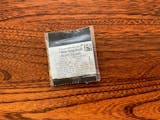
Table King Bush Acorn Squash
$3.95
100%
Non-GMO
Free
Shipping
Service
Guaranteed
Acorn Squash is one of the plants grown in the traditional Native American vegetable growing technique called the Three Sisters. The other two plants in the Three Sisters are beans and corn. Each plant had its role in this companion planting tradition. Corn served as a structure for the vining beans to grow up. Squash served as a ground cover to prevent weeds from growing. Beans provided natural fertilizer for all.
Also Known As: Pepper Squash, Des Moines Squash, Danish Squash, Table Queen Squash, Winter Acorn Squash, Green Acorn Squash, White Acorn Squash, Golden Acorn Squash, Bush Acorn Squash, Autumn Acorn Squash.
| Plant Name: | Winter Squash, Table King Bush |
| Latin Name: | Cucurbita pepo |
| Days to Germinate: | 7-14 |
| Days to Harvest: | 90 |
| Plant Height: | 18 - 24 Inches |
| Spread: | 4 - 6 Feet |
| Growth Habit: | Bush |
| USDA Zones: | 3-9 |
| Lifespan: | Annual |
| Brand: | TomorrowSeeds |
| Sunlight: | Full Sun, Partial Shade |
| Pollination: | Heirloom, Open-Pollinated |
| GMO: | No |
| Fungicide-Treated Seeds*: | No |
| Seeds Packed For**: | 2025 |
**Seeds are freshly packed for the growing season of the year listed. Seeds are still viable beyond pack date. Store in a cool and dry location such as the refrigerator or basement to best preserve germination rates.
Planting Instructions:
Soil Preparation:
Choose an area with heavy, well-draining soil that receives at least 6 hours of sunlight each day. Remove weeds, large rocks, and litter from the planting area. Leave small weeds and dead grass, they will enrich the soil when turned under. Spade or till the soil 8-12 inches deep. Loosening the soil will help the plant establish strong roots.
Squash grows best in soil with lots of organic matter. You may optionally add fertilizer or organic material such as compost, leaves, or rotted hay to mix into the soil at this point. For small gardens, scatter 2-3 tablespoons of fertilizer evenly and work into the top 2-3 inches of soil for each hill or 2 foot by 2 foot planting area. For larger gardens, scatter 2-3 pounds of a complete fertilizer for each 100 square feet of planting area. Work fertilizer or organic material into the soil and leave the surface smooth.
Form rows of soil beds 4-6 inches high and at least 3 feet apart. This formation of ridges will help with drainage.
Planting:
Plant squash in the spring after all danger of frost has passed and the soil begins to warm. Planting early ensures squash will mature before the first killing frost. To plant, make holes 1 inch deep and spaced 2-3 feet apart down the rows of raised beds. Plant 1-3 seeds per hole, planting 2-3 seeds if choosing to thin to the strongest plant. When thinning, wait until seedlings grow 1-2 sets of leaves before determining the strongest and healthiest plant, then remove all other plants, narrowing to a single plant per hole. Cover seeds thinly with soil and water after planting.| Planting Depth: | 1 inch |
| Within-Row Spacing: | 2-3 feet |
| Between-Row Spacing: | 4-6 feet |
Care During the Season:
Watering: Water the plants enough to keep them from wilting. If the weather is really dry, water squash plants at least once a week. Sandy soils may need to be watered more often than heavy clay soils.
Weeding: Keeping squash plants weed-free improves production. If plowing or hoeing, do not dig deeper than 1 inch to prevent from cutting the feeder roots.
Fertilizing: When blooms first appear, you may optionally apply 2 tablespoons of fertilizer around each hole, without letting the fertilizer touch the plants. Water plants after fertilizing.
Insecticides: Insecticides may be used to protect plants. Bt-based insecticides and sulfur are organic options that can be used for prevention. Sulfur also has fungicidal properties and helps in controlling many diseases. Before using a pesticide, read the label and follow cautions, warnings and directions.
Diseases: If spots or mold appear, treat plants with an approved fungicide. Neem oil, sulfur, and other fungicides may be used. When using fungicides always follow label directions.
Harvesting:
Acorn squash is ready to harvest when the skin turns dark green with an orange patch where it rested on the ground, and the rind becomes hard and resistant to scratching. The stem will also dry and turn brown, and the squash should reach its full size of 4–7 inches. It’s typically ready 75–100 days after planting and should be picked before the first frost. Use pruning shears to cut the squash, leaving 1–2 inches of stem attached for better storage.



















